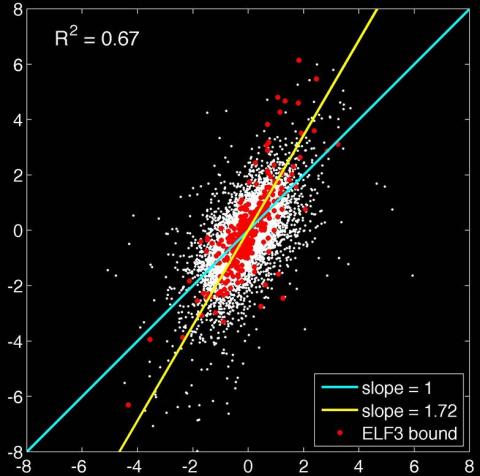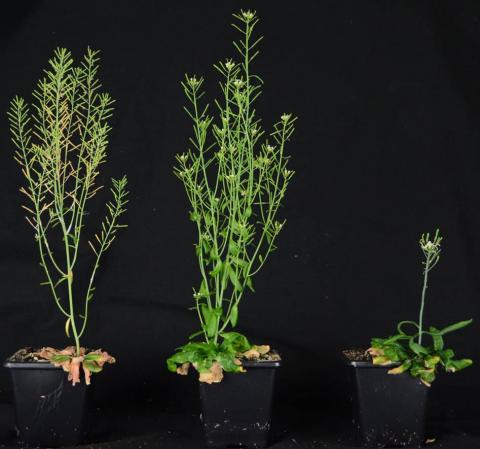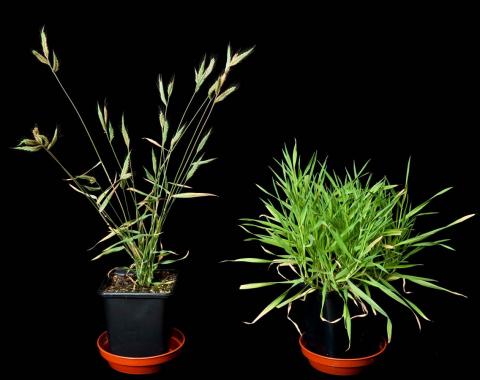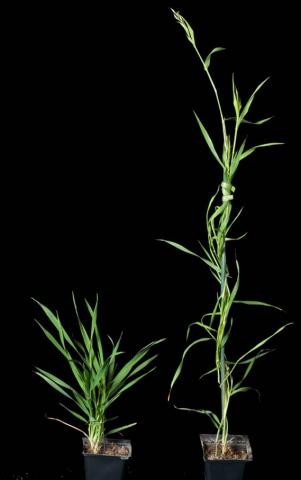Dr Katja Jaeger was a Career Development Fellow at SLCU between 2013-2018. This page summarises the research areas that her former group focused on.
Dr Katja Evelyn Jaeger
Former Career Development Fellow at SLCU
Research Interests
We are interested in understanding how plants control their development in response to a changing environment. Sensing, integrating and remembering environmental information allows plants to make key life-cycle decisions at the right time to optimize fitness. These questions are of interest from both a fundamental scientific perspective as well as having potential for application in breeding stress-resilient crops.
We are studying these processes in two systems: Arabidopsis thaliana, which offers unparalleled genetic and epigenetic resources and the small grass Brachypodium distachyon, which is related to crop plants such as wheat, barley and rice. Brachypodium is an ideal model species for our research questions. It has a small genome that is fully sequenced, excellent genetics, and is easily transformable, enabling the use of emerging CRISPR/Cas9 approaches for highly precise genetic intervention.
We are particularly interested in how plants exploit their developmental plasticity to adapt to their environment. Key questions we are addressing include:
How conserved is the floral induction pathway?
The induction of flowering is a key developmental decision. Plants integrate multiple environmental cues including temperature, photoperiod and light quality to flower in the correct season. Previously, we and others have shown that in Arabidopsis a mobile peptide is generated in the leaves in response to inductive conditions and that this florigenic signal moves to the apex, triggering flowering. To understand the regulatory logic underpinning the floral transition we have adopted a mathematical modelling approach with Richard Morris (John Innes Centre, Norwich, UK).
To understand the extent to which this system is conserved between the dicot Arabidopsis and monocots, we are investigating flowering in Brachypodium. We are adopting a molecular genetic approach in this species and this will enable us to extend our computational model to Brachypodium. Furthermore, we aim to expand the model to integrate diverse environmental conditions and predict the phenotype of a given genotype in a given environment.
How do plants remember temperature stress?
To maximise reproductive success plants need to be able to sense, integrate and adapt to a variable environment. Heat stress has a profound effect on plant development and the plant response is controlled by a complex gene regulatory network. Interestingly, plants pre-exposed to a moderate (priming) heat stress can become tolerant to a subsequent severe heat stress that is lethal to naive plants. This phenomenon is termed acquired thermotolerance and can be maintained for several days (also called heat stress memory). We are currently studying the molecular mechanisms underlying acquired thermotolerance in Brachypodium and the integration of light signalling into the acclimation response using next-generation sequencing approaches and conventional genetic screens.
How is growth and development coordinated with environmental signals?
A fundamental question in biology is to understand how the information encoded within a genome interacts with the environment to determine the final developmental outcome. The remarkable flexibility of plant development suggests the presence of pathways and mechanisms to adjust growth and developmental responses to the environment.
We exploit next-generation sequencing capacity to understand dynamic plant developmental responses to the environment. Essentially, the ability to obtain temporal and spatial maps at high resolution for gene expression and chromatin status revolutionizes our ability to understand how development is implemented via gene regulatory programs. This will enable us to make predictive models for developmental programs and go beyond model systems in the direct engineering of traits of interest in crops.
Selected publications
Chloroplast signalling gates thermotolerance in Arabidopsis. Dickinson, P.J., Kumar, M., Martinho, C., Yoo, S.J., Lan, H., Artavanis, G., Charoensawan, V., Schöttler, M.A., Bock, R., Jaeger, K.E., and Wigge, P.A. (2018) Cell Reports 22, 1-9.
Transcriptional regulation of the ambient temperature response by H2A.Z-nucleosomes and HSF1 transcription factors in Arabidopsis. Cortijo S., Charoensawan V., Brestovitsky A., Buning R., Ravarani C., Rhodes D., van Noort J., Jaeger K.E, and Wigge P.A (2017). Mol. Plant. doi: 10.1016/j.molp.2017.08.014.
The G-box transcriptional regulatory code in Arabidopsis
Daphne Ezer, Samuel JK Shepherd, Anna Brestovitsky, Patrick Dickinson, Sandra Cortijo, Varodom Charoensawan, Mathew S Box, Surojit Biswas, Katja Jaeger, Philip A. Wigge. Published September 2017.
The evening complex coordinates environmental and endogenous signals in Arabidopsis., Ezer D, Jung JH, Lan H, Biswas S, Gregoire L, Box MS, Charoensawan V, Cortijo S, Lai X, Stöckle D, Zubieta C, Jaeger KE, Wigge PA, Nat Plants. 2017 Jun 26;3:17087. doi: 10.1038/nplants.2017.87., PMID:28650433
Jung JH., Domijan M., Klose C., Biswas S., Ezer D., Gao M., Khattak AK., Box MS., Charoensawan V., Cortijo S., Kumar M., Grant A., Locke JC., Schäfer E., Jaeger KE., Wigge PA. Phytochromes Function as Thermosensors in Arabidopsis, Science in press. DOI: 10.1126/science.aaf6005
ELF3 controls thermoresponsive growth in Arabidopsis (2015) Box MS, Huang BE, DomijaN, D, Jaeger KE, Khattak AK, Yoo SJ, Sedivy EL, Jones DM, Hearn TJ, Webb AAR, Grant A, Locke JCW, Wigge PA Current Biology 25: 1-6
Interlocking feedback loops govern the dynamic behavior of the floral transition in Arabidopsis. Jaeger KE, Pullen N, Lamzin S, Morris RJ, Wigge PA. (2013) Plant Cell. 25(3):820-33
Transcription factor PIF4 controls the thermosensory activation of flowering. Kumar SV, Lucyshyn D, Jaeger KE, Alós E, Alvey E, Harberd NP, Wigge PA. Nature. 2012 Mar 21;484(7393):242-5.
FT protein acts as a long-range signal in Arabidopsis. Jaeger KE, Wigge PA. Curr Biol. 2007 Jun 19;17(12):1050-4.
Integration of spatial and temporal information during floral induction in Arabidopsis. Wigge PA, Kim MC, Jaeger KE, Busch W, Schmid M, Lohmann J, Weigel D. Science. 2005 Aug 12;309(5737):1056-9.




